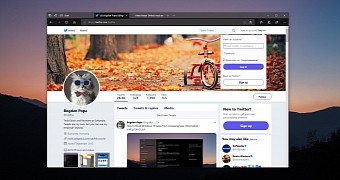It’s official now: Microsoft is giving up on its very own browser and becomes a contributor to the Chromium project in order to provide Windows 10 users with a custom version of Google Chrome.
Basically, Microsoft is doing the right thing, as I’ve said several times in the last few days, because all its efforts to make Microsoft Edge a hit have pretty much failed.
While I’m not going to dissect the reasons that turned Edge from a very promising browser into another Microsoft failure, the switch to Chromium can bring the software giant back on track in the browser market.
But at the end of the day, this is only possible if Microsoft plays its card right, as just switching to Chromium doesn’t guarantee that users would migrate off Google Chrome en masse.
In fact, while Microsoft is already working on a Chromium-based browser, with a preview due in 2019, I’m being told the project is still in its early days, so there’s a lot of work to do here.
The announcement that Microsoft released earlier today is supposed to provide us with the essential information on how the company is rebooting its efforts in the browser battle, but in fact, it also leaves three very important questions answered.
Will it definitely work on Windows 7?
First and foremost, Microsoft says that by switching to Chrome, it’s much easier to release Microsoft Edge on other platforms too, including previous Windows versions.
“We will evolve the browser code more broadly, so that our distribution model offers an updated Microsoft Edge experience + platform across all supported versions of Windows, while still maintaining the benefits of the browser’s close integration with Windows,” the company says (emphasis is ours).
Basically, this means the “new” Microsoft Edge would work on Windows 7 too, right? Right. Because it still receives support, Windows 7 would be one of the operating system where the Chromium-based Edge would run natively.
However, it all depends on timing. With the new browser expected to land sometime next year, it means it could be released on Windows 7 only a few months before Microsoft retires the operating system in January 2020.
A new browser would represent another reason for users not to leave Windows 7 behind, and I’m pretty sure Microsoft doesn’t want to go in this direction. But if Windows 7 isn’t supported, it means that “all supported versions of Windows” would basically come down to Windows 10 and Windows 8.1.
How is it going to be updated?
As long-time Windows 10 users certainly know, the update system for Microsoft Edge was one of the biggest setbacks for the browser. Microsoft delivered updates as part of Windows 10 feature updates, and security patches landed every month of Patch Tuesday.
In other words, new features landed twice every year, while the likes of Google Chrome and Mozilla Firefox received updates at a much faster pace.
How will this new browser be updated? Will it be published in the Microsoft Store for more frequent updates? This is something that Microsoft needs to answer.
How will the transition from the old to the new browser be supposed to work?
Microsoft also needs to provide users in general, and developers in particular, with more details on the future of the current Microsoft Edge browser once its replacement hits the market.
Having two different browsers with the same name and user interface isn’t obviously the best way to go, so I think that Microsoft will retire the current version.
But what will then happen with all the work that developers have made for optimizing their apps and services for Microsoft Edge? Again, Microsoft needs to explain these changes in the smallest details.
For those wondering, a specific ETA as to when the browser would launch isn’t yet available, but a first version is expected in just a few months. This means the company has a lot of time to answer all these questions, but also to refine its strategy should it need more adjustments.

 14 DAY TRIAL //
14 DAY TRIAL //